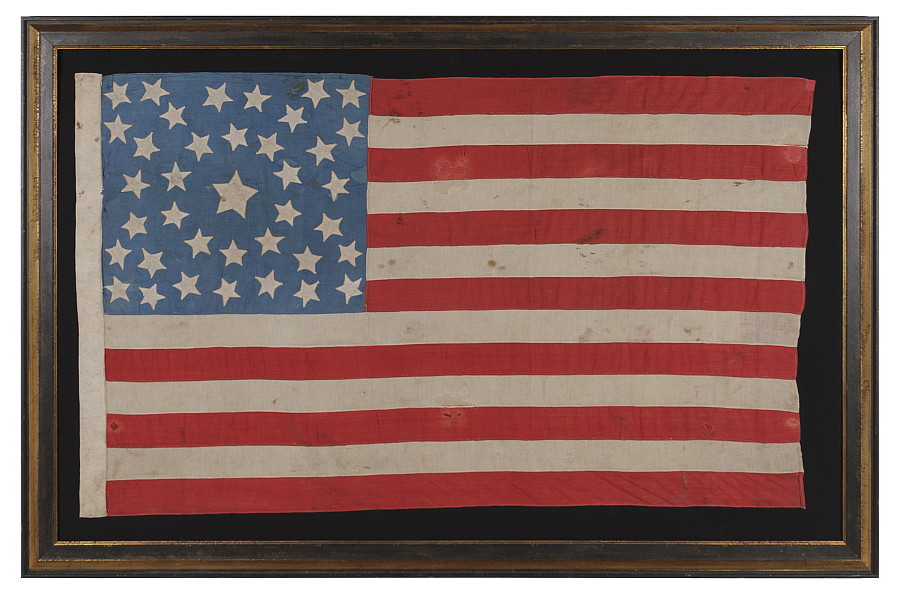
| |
38 STARS ON A CORNFLOWER BLUE CANTON, IN A MEDALLION CONFIGURATION, WITH A RARE GROUPING OF 3 STARS IN EACH CORNER, 1876-1889, COLORADO STATEHOOD |
|
| Available: |
Sold |
| Frame Size (H x L): |
54" x 83" |
| Flag Size (H x L): |
43" x 71.25" |
|
| Description....: |
|
38 STARS ON A CORNFLOWER BLUE CANTON, IN A MEDALLION CONFIGURATION, WITH A RARE GROUPING OF 3 STARS IN EACH CORNER, 1876-1889, COLORADO STATEHOOD:
38 star American national flag in a desirable small size compared to its 19th century counterparts, with some unusual and attractive features. The stars are arranged in a medallion pattern that consists of two concentric wreaths of stars, surrounding a larger center star, with a trio of three stars flanking in each corner. A traditional medallion design has one, two, or three wreaths, with a star in the center and just one star in each corner. Variations on this design with multiple stars in each corner are much more unusual. One theory on the use of triangles of three stars in a centennial era flag is that the illustration might represent the tri-corner hats of Revolutionary War patriots. This could as easily be fiction as fact, but much symbolism is contained in the star patterns of early flags, especially those made between the Civil War and the 1876 centennial.
Note the attractive and unusual color of the, cornflower blue canton. Just as there was no official star pattern for the Stars & Stripes until 1912, likewise there were no official shades of red and blue, no official proportions, and no official shape for the stars, which were usually 5-pointed, but sometimes had 4, 6, 7, 8, or 10 points. Note how the stars of this flag are particularly fat; a trait that is particularly pronounced in the large center star. Attributes such as these raise interest among both flag collectors and casual observers alike.
Despite the fact that this might seem to be a large flag by modern standards, it is small in scale among those made for extended outdoor use prior to 1890. During the 19th century, flags with pieced and sewn construction (as opposed to printed) were typically eight feet long or larger. This is because they were important in their function as signals, meaning that they needed to be seen and recognized from a great distance. Even flags made for decorative purpose were generally very large by today's standards. A small flag was six feet in length, like this example. Production of flags smaller than this with sewn construction was extremely minimal. Military flank-markers and camp colors are an exception, but surviving examples of these forms are rare. Since the average 19th century sewn flag can be cumbersome to frame and display in an indoor setting, many collectors prefer printed parade flags and smaller sewn flags, like this one.
The 38th state, Colorado, joined the Union on August 1st, 1876. This was the year of our nation's centennial of independence from Great Britain. Although 37 was the official star count in 1876, flag-making was a competitive venture and no one wanted to be making 37 star flags when others were making 38's. It is for this reason that 38 and 13 (to reference the original 13 colonies) are the two star counts most often seen during the centennial events.
The 38 star flag was generally used until 1889, when four new states joined the Union. Decorative star patterns, however, like this one, tend to be seen on 38 star flags that were made specifically for 1876 events, such as the Centennial International Exposition in Philadelphia, a six-month long, World's Fair event, held in conjunction with the nation's anniversary.
Construction: This is a homemade flag. The canton, stripes, and hoist binding are made of lightweight cotton bunting. The stars are made of cotton and appliquéd to the obverse only. All of the piecing and appliqué work was done with treadle stitching.
Mounting: The flag was stitched to 100% natural fabrics on every seam and throughout the star field both for support and for masking purposes. It was then sewn to a background of 100% cotton twill, black in color, which was washed to remove excess dye. An acid-free agent was added to the wash to further set the dye and the fabric was heat-treated for the same purpose. The mount was then placed in a black-painted, hand-gilded and distressed Italian molding. The glazing is U.V. protective acrylic.
Condition: There are minor to moderate holes, accompanied by minor to moderate foxing and staining. Fabrics of similar coloration were placed behind the flag during the mounting process to ghost out losses. Many of my clients prefer flags that show their age and history of use. |
|
|
|
| Collector Level: |
Advanced Collectors and the Person with Everything |
|
| Flag Type: |
Sewn flag |
|
| Star Count: |
38 |
|
| Earliest Date of Origin: |
1876 |
|
| Latest Date of Origin: |
1889 |
|
| State/Affiliation: |
Colorado |
|
| War Association: |
1866-1890 Indian Wars |
|
| Price: |
SOLD |
|
| |
Views: 3033 |
|
|
|

